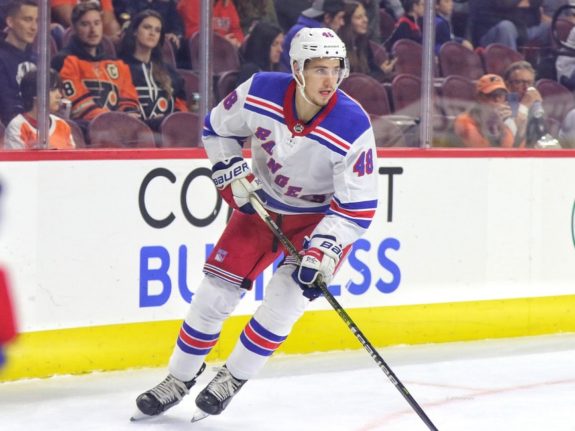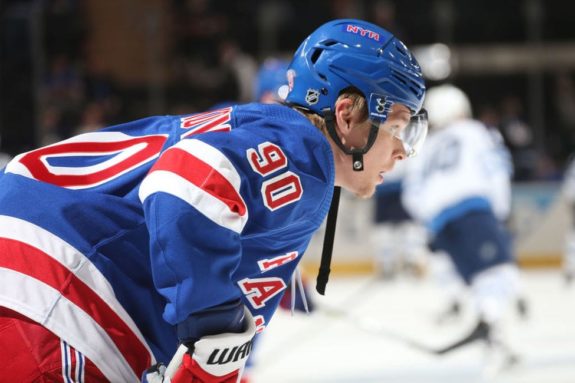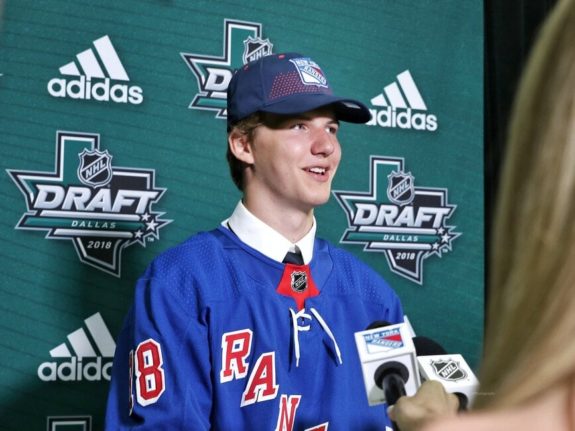The New York Rangers really have no one to blame but themselves for the hype swirling around them with training camp on the horizon.
Their 18-month rebuild has yielded high-end prospects, many of whom appear ready to challenge for significant roles next season. They’ve acquired of a pair of right-shooting defensemen – one of the biggest commodities in the NHL – to accelerate the badly needed restructuring of the blue line. And of course, there was the move that really got the excitement boulder rolling downhill – the winning of the Artemi Panarin free-agent sweepstakes.
The arrival of Panarin, Jacob Trouba, Adam Fox, Kaapo Kakko, Vitali Kravtsov and others has led to the steady inflating of expectations for this team. More than a few observers began by predicting a return to the playoffs; it didn’t take long for that to morph into a “Stanley Cup contender” in some circles.
That could prove dangerous for this club. Especially if fans buy into the upper echelons of that hysteria.

Unrealistic goals have been heaped upon these youthful Rangers, who may very well endure a resurgent season but simply aren’t ready to compete for a championship yet. Panarin is the proven star, but projecting Kakko and Kravtsov and Fox as certain to make major impacts in 2019-20 represents an unrealistic leap of faith.
The growing pains of adjusting to the speed and skill and length of a season in the NHL, not to mention a new culture for Kravtsov and Kakko, are sure to strike all of the rookies at some point, even if those bumps in the road might be smaller due to the apparently elite skills of each. It’s even possible that – gasp! – one or more of the kids will need some time in the AHL as part of their development. That, of course, remains the theme within the organization, even if some outside it insist that a Stanley Cup is right around the corner.
The most overlooked area of concern for this overhyped team, however, is one that could prove problematic not just this season, but in years to come – and threatens to undermine the process of the Blueshirts’ “build,” as team brass has chosen to label their process of renewal.
Rangers Have Zibanejad and Uncertainty at Center
That would be down the middle, where the Rangers boast a No. 1 center in Mika Zibanejad and three largely unproven commodities – all of whom have shown promise, as well as reason for doubt, in their long-term prospects. What makes this issue all the more disconcerting is that this now-cap challenged club has tied its fortunes to those three up-and-comers developing into productive NHL centers.
Filip Chytil, Lias Andersson and Brett Howden were first-round draft picks. All exhibited a handful of signs that they might grow into keepers at times during last season. And all of them are 21 or younger, with Chytil’s teen years set to end Sept. 5.
The fact is, the Rangers don’t really have any idea what they have beyond Zibanejad at the critical center position.
Chytil recorded 11 goals and 12 assists in 75 games in his first full NHL season. He oozes offensive talent with his elite hands and effortless skating, and he had modest success after the Rangers paused his apprenticeship on the wing and moved him to his natural spot later in 2018-19. Is he on the verge of seizing the second-line center assignment? Will his work at the faceoff dot and defensive awareness prove good enough to rise to that status, or is he ultimately better suited to playing on the outside?
Chytil is an earnest and to this point somewhat shy 19-year-old, his grasp of English improving and his comfort level rising since arriving from the Czech Republic two years ago as the 21st pick in the 2017 draft. Does his confidence and grasp of the North American game follow as he grows and matures?
Howden, part of the blockbuster Ryan McDonagh-J.T. Miller trade with the Tampa Bay Lightning in Feb. 2018, surprisingly made the Rangers out of camp last season, opening eyes with his heady all-around play. The 6-foot-3, 195-pounder scored twice in his first four games, but hit the rookie wall in November, missing a month with a sprained knee and didn’t exhibit the same jump he had shown early in the season after that. He finished with six goals and 17 assists in 66 games. Howden’s impressive game has room for growth – but he might also top out as a third-line pivot if he doesn’t produce enough offense. Will he score enough to justify being in the lineup every night?

Andersson might represent the biggest question mark and perhaps, unfortunately, could be the young center on whom the Rangers are counting on the most. Plenty of eyebrows went up when the Blueshirts drafted him seventh overall in 2017, with supposedly higher-ceilinged players still on the board. To this point, the soon-to-be 21-year-old Swede has done little to dispel that draft-day impression.
Andersson has size, grit and competitiveness. Of the three young centers, though, he’s the only one who didn’t really “flash,” his best moments coming during the preseason. Questions about his skating and hands abound. That’s problematic for the Rangers, who should expect – and really, need – to have selected a difference-making center at seventh-overall. If Andersson’s ceiling is as a third- or even fourth-liner, or if he fails to stick at all, the “build” could be significantly stunted should Chytil and/or Howden struggle to establish themselves.
Rangers’ Other Options at Center Aren’t Great
There are so-so short-term options should any of the three youngsters take steps back. Veteran Ryan Strome is around after seeming to find a niche on Broadway following his acquisition in a lopsided trade with the Edmonton Oilers for Ryan Spooner. He recorded 18 goals and 15 assists while winning 47 percent of his faceoffs in 63 games, shifting between center and the wing.
Strome, 26, is also a former fifth-overall pick who’s on his third team in seven seasons and posted a shooting percentage of 22.5 in a Blueshirt last season – nearly doubling his previous best. A regression to something in the ballpark of his career norm of below 10.0 should hardly come as a surprise.
Vladislav Namestnikov, a natural center who took advantage of playing on a line with Steven Stamkos and Nikita Kucherov on the Lightning before becoming a throw-in for the McDonagh-Miller deal, remains on the roster after attempts to move his $4 million cap hit went nowhere. Namestnikov, a first-round pick of Tampa Bay in 2011, was a teammate of Panarin’s on the Russian team for the 2017 World Championship and the World Cup that same year. They have little history of playing together, however, and though elite players certainly brought the best out of Namestnikov with the Lightning, Panarin is ticketed to at least start the season being centered by Zibanejad on the top line. Pavel Buchnevich, Kakko or Kravtsov are the first three in line to join them.

Namestnikov is likely to serve as insurance in the middle while getting most of his time as a bottom-six winger – if he can crack the Rangers’ revamped lineup. He posted 20 goals and 24 assists in 62 games with Tampa Bay in 2017-18 riding shotgun to Stamkos and Kucherov before being dealt to the Rangers. The so-so results he’s delivered in a season-plus in New York seem to indicate that playing with two of the best players in the world inflated his production.
He could again prove to be a master of fortuitous timing, however, should the young centers struggle and Zibanejad and Panarin prove to be better apart than together.
Both Strome and Namestnikov, though, are all but certain to be gone after this season (if not before), their expiring contracts bringing the Rangers $7.1 million in desperately needed cap room in 2020-21. With so little space after the signing of Panarin ($11.6 million cap hit over seven seasons) and numerous young projected cornerstones needing to be re-signed in the next few seasons, Chytil, Howden and Andersson – all with two years remaining on their entry-level deals – should prove critical to the organization’s hope of an impending return to contention.
There’s also 25-year-old Cristoval Nieves, a second-round pick in 2012 who had moments in 43 games last season but whom the organization at this point views largely as a fourth-liner or insurance against injury.
There probably just won’t be a lot of room for a big-ticket free-agent acquisition in the middle. The Rangers stand to gain more than $20 million in cap space after 2020-21, but they’ll need to allot a good amount of that to new deals for Kakko, Kravtsov, Fox, Igor Shesterkin, Libor Hajek and others – not to mention Chytil, Howden and Andersson.

The Rangers are still in development mode. Fans have every right to be excited about the possibilities, but they’ll probably want to temper that a bit with a pinch of reality – and perhaps a dash of anxiety over whether the youth assembled at center will be able to solidify a position that the Blueshirts have struggled to adequately fill for years.
If it can’t, the Rangers could find themselves trying to “build” without a key element of foundation – a problem that could prove very difficult to address.